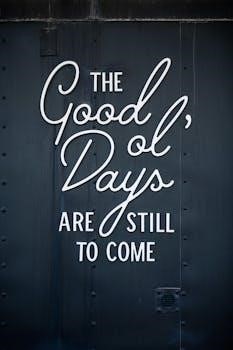Goodfellas Script⁚ An Overview
Goodfellas, a 1990 American biopic film, directed by Martin Scorsese, is based on Nicholas Pileggi’s book, Wiseguy. The screenplay, co-written by Scorsese and Pileggi, is a masterclass in storytelling. The script has excellent characters, quotes, and story resolution, making it a classic.
Origin and Adaptation
The screenplay for Goodfellas originated from Nicholas Pileggi’s non-fiction book, Wiseguy, which chronicled the life of mob associate Henry Hill. Martin Scorsese, deeply fascinated by the material, collaborated with Pileggi to adapt the book into a screenplay. The adaptation process involved transforming the extensive narrative of Hill’s life into a cohesive cinematic structure. Scorsese and Pileggi focused on the key events and relationships to create a compelling story. The film’s narrative style is heavily influenced by Pileggi’s journalistic approach, providing a detailed and realistic portrayal of mob life. The collaboration between the director and author ensured the script captured the essence of the source material, while also creating a distinct cinematic experience. This adaptation is often cited as an example of how to successfully translate a book to the big screen.

The Collaboration of Scorsese and Pileggi
Martin Scorsese and Nicholas Pileggi collaborated closely on the Goodfellas screenplay. Pileggi, the author of Wiseguy, brought his deep knowledge of the subject, while Scorsese provided his cinematic vision.
Screenwriting Duo
The screenwriting partnership between Martin Scorsese and Nicholas Pileggi was crucial to the success of Goodfellas. Pileggi’s intimate knowledge of the mob world, gained from his research for the book Wiseguy, provided the authentic foundation for the script. Scorsese, with his signature directorial style, brought the story to life with dynamic pacing and visual flair. Their collaboration resulted in a script that is both gritty and engaging. Pileggi’s experience as a journalist lent a documentary feel to the narrative, while Scorsese’s expertise in character-driven storytelling added depth and nuance; Together, they crafted a script that is fast-paced, crisp, clear, and exciting. They worked on the screenplay collaboratively, ensuring that the dialogue was both realistic and memorable. This partnership proved to be a perfect blend of journalistic accuracy and cinematic artistry. The screenplay is considered a prime example of a well-structured script with memorable characters and sharp dialogue, showcasing the power of a successful screenwriting team.

Key Elements of the Goodfellas Script
The Goodfellas script is a masterclass in storytelling, exhibiting key elements like intricate characters, snappy dialogue, and a unique narrative structure. It is a fast-paced, clear and exciting script, a published version.
Narrative Structure
The narrative structure of the Goodfellas script is a key element contributing to its success. The film uses a non-linear storytelling approach, jumping through time to portray Henry Hill’s life from childhood to adulthood. The film is narrated by Henry himself, providing an intimate and personal perspective on the events. This technique allows the audience to connect with the protagonist and understand his motivations. The script avoids a traditional plot structure, opting for a series of vignettes and episodes that showcase the chaotic and unpredictable nature of mob life. This episodic format keeps the narrative fresh and engaging, with each scene revealing new facets of the characters and their world. The film’s structure is less about a singular plot and more about a journey through the experiences of the main character, giving the narrative a unique flow. This approach emphasizes the cyclical nature of Henry’s involvement in the mob, as well as his eventual downfall.
Character Development
The script of Goodfellas is renowned for its exceptional character development, with each character, from Henry Hill to Jimmy Conway and Tommy DeVito, being multi-layered and complex. Henry’s journey from an innocent boy to a hardened mobster is meticulously portrayed, with his internal struggles and motivations clearly defined through the narrative. Jimmy Conway is presented as a calculating and charismatic figure, whose ruthlessness is tempered by his loyalty to his friends. Tommy DeVito, on the other hand, is portrayed as volatile and unpredictable, adding an element of danger to the group dynamic. The script also explores the complexities of female characters, particularly Karen Hill, whose transformation from an outsider to a mob wife is both compelling and tragic; The characters are not simply stereotypes; they are individuals with flaws, making them feel real and relatable despite their criminal activities. The script uses dialogue and actions to reveal their inner lives, creating a dynamic and engaging ensemble.

Thematic Depth in the Script
The Goodfellas script delves into the allure and brutality of mob life, exploring themes of loyalty, betrayal, and the corrupting influence of power. The film also examines the American dream and its dark underbelly.
Exploration of Mob Life
The script meticulously portrays the intricacies of mob life, showcasing its crude hierarchies, casual violence, and the constant pursuit of wealth. It delves into the daily routines, rituals, and code of conduct that govern the lives of these “wiseguys.” The narrative captures the intoxicating allure of power and belonging that draws individuals into this world, while also exposing its inherent dangers and moral bankruptcy. The screenplay doesn’t shy away from depicting the brutal realities of their existence, including murder, robbery, and drug trafficking, painting a vivid picture of the gangster lifestyle. It explores how the characters rationalize their actions and the consequences that inevitably follow. The script also shows how the mobsters view themselves as a family of ‘goodfellas,’ but it also shows how that sense of community is built on a foundation of fear and violence.

Analyzing the Goodfellas Ending
The ending of Goodfellas provides a resolution for the mobsters, while also commenting on the sensationalism often associated with the genre. It’s an interesting aspect that includes Henry’s voiceover and his eventual decision to rat out his accomplices.
Resolution and Commentary
The conclusion of Goodfellas offers a stark resolution, showcasing the consequences of a life entrenched in crime. Henry Hill, the protagonist, ultimately betrays his associates, entering witness protection, a move that underscores the brutal realities of the mob world. This act of self-preservation brings a sense of finality to his narrative, effectively dismantling the romanticized portrayal of gangster life that the film initially presents. The ending serves as a commentary on the sensationalized perception of the mafia, revealing the betrayal, fear, and paranoia that are inherent to the lifestyle. The film pulls back the curtain, revealing the rather unglamorous and unsatisfying truth behind the facade of power and respect that the “goodfellas” aspire to. This resolution is not a triumphant one but a bleak reminder of the price of criminal ambition and the inherent instability of the mob world. The concluding scenes with Henry living an ordinary life emphasize the stark contrast between the allure of crime and the mundane reality that awaits those who leave it.
Script’s Impact and Legacy
The Goodfellas script has had a profound influence on filmmaking, with its innovative narrative and character development. Its legacy extends to its availability in published form, including PDF versions, making it accessible to aspiring screenwriters.
Influence on Filmmaking
The Goodfellas script, with its unique blend of voice-over narration, fast-paced editing, and realistic portrayal of mob life, has significantly impacted filmmaking. The film’s innovative approach to storytelling, particularly its non-linear structure and use of freeze-frames, has been widely emulated by other directors. Its influence can be seen in countless crime films and television series. The script’s sharp, authentic dialogue has also set a new standard for the genre, inspiring writers to craft more nuanced and believable characters. Furthermore, the film’s exploration of the moral ambiguities of its characters challenged the traditional good versus evil dichotomy in crime narratives. The distinct visual style of Goodfellas, often attributed to Scorsese’s direction, is deeply rooted in the screenplay’s detailed scene descriptions and character motivations. This has encouraged filmmakers to pay close attention to visual storytelling and to integrate visuals seamlessly with the narrative. The film’s lasting influence is a testament to the power of a well-written script.
Availability of the Script
The Goodfellas script is readily available for those interested in studying it or simply enjoying it as a piece of literature. Various online platforms offer access to the screenplay, often in PDF format, making it easy to read on various devices. Websites dedicated to screenwriting resources often host the script, allowing aspiring writers to learn from one of the best examples of the genre. Additionally, physical copies of the screenplay can be found in bookstores and online retailers, sometimes as part of film script collections. These published versions often include additional material, such as notes on the script’s development or introductions from the writers. The availability of the script has facilitated its use in film schools and universities, where it serves as a valuable teaching tool. Access to the script allows fans to delve deeper into the film’s narrative structure and character dynamics, enhancing their appreciation for the film. The Goodfellas script is a valuable resource for anyone interested in the art of screenwriting.
Where to Find the PDF
Locating a PDF version of the Goodfellas script is quite straightforward thanks to the internet. Several websites specialize in providing screenplays for educational and entertainment purposes. These sites often host a variety of scripts, including the one for Goodfellas, in downloadable PDF format. You can typically find these scripts by searching for “Goodfellas script PDF” using any search engine. Script Slug, for example, is a resource where you can find the screenplay. Additionally, websites that cater to screenwriters often provide links to downloadable scripts. It is important to ensure the source you are using is reputable to avoid any potential issues with file downloads. Some online libraries and digital archives may also offer the script as part of their collection. Always exercise caution when downloading files from the internet, ensuring that you are using secure and trustworthy sources. Remember that these scripts are often provided for educational purposes.




Leave a Reply
You must be logged in to post a comment.